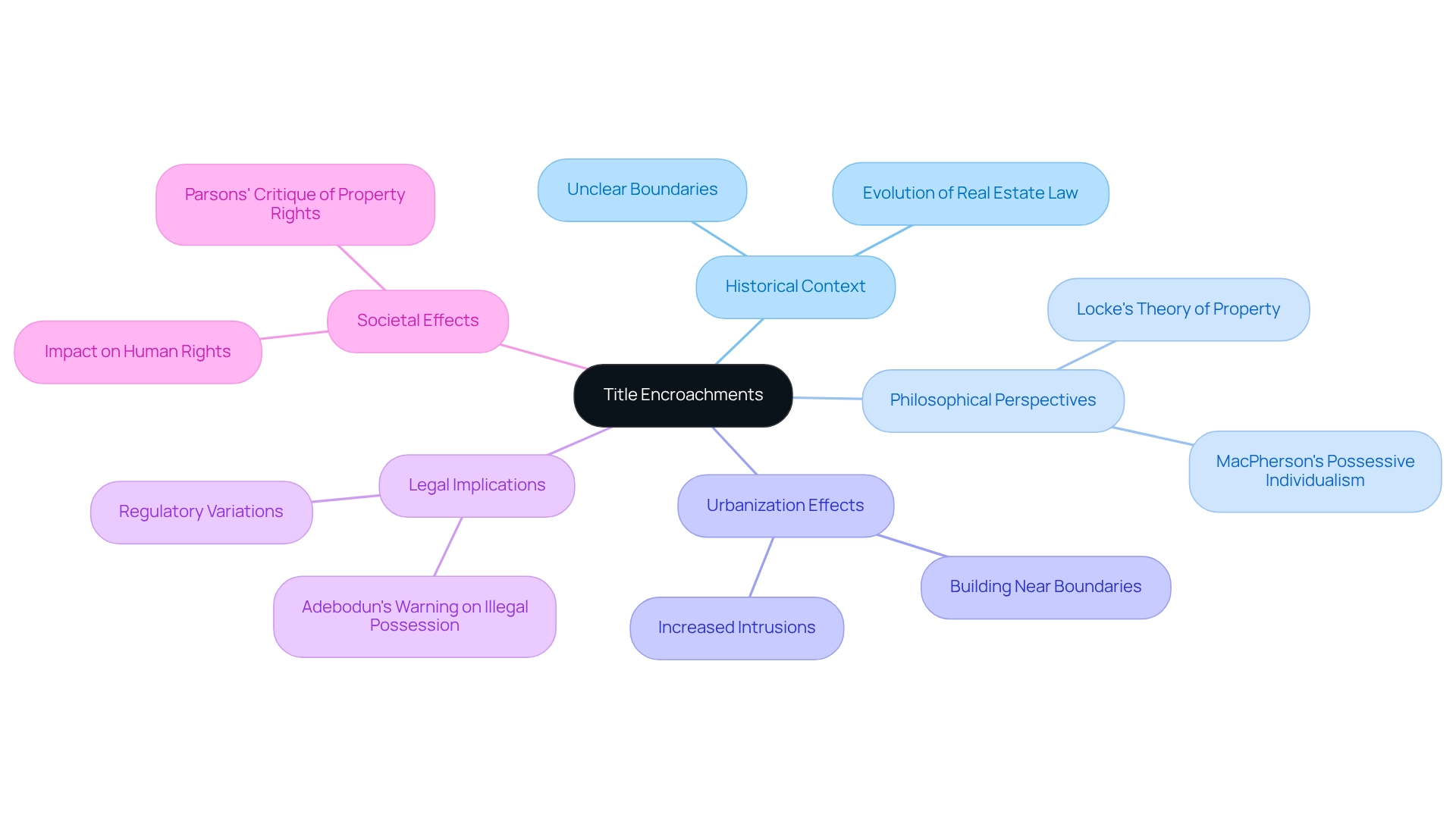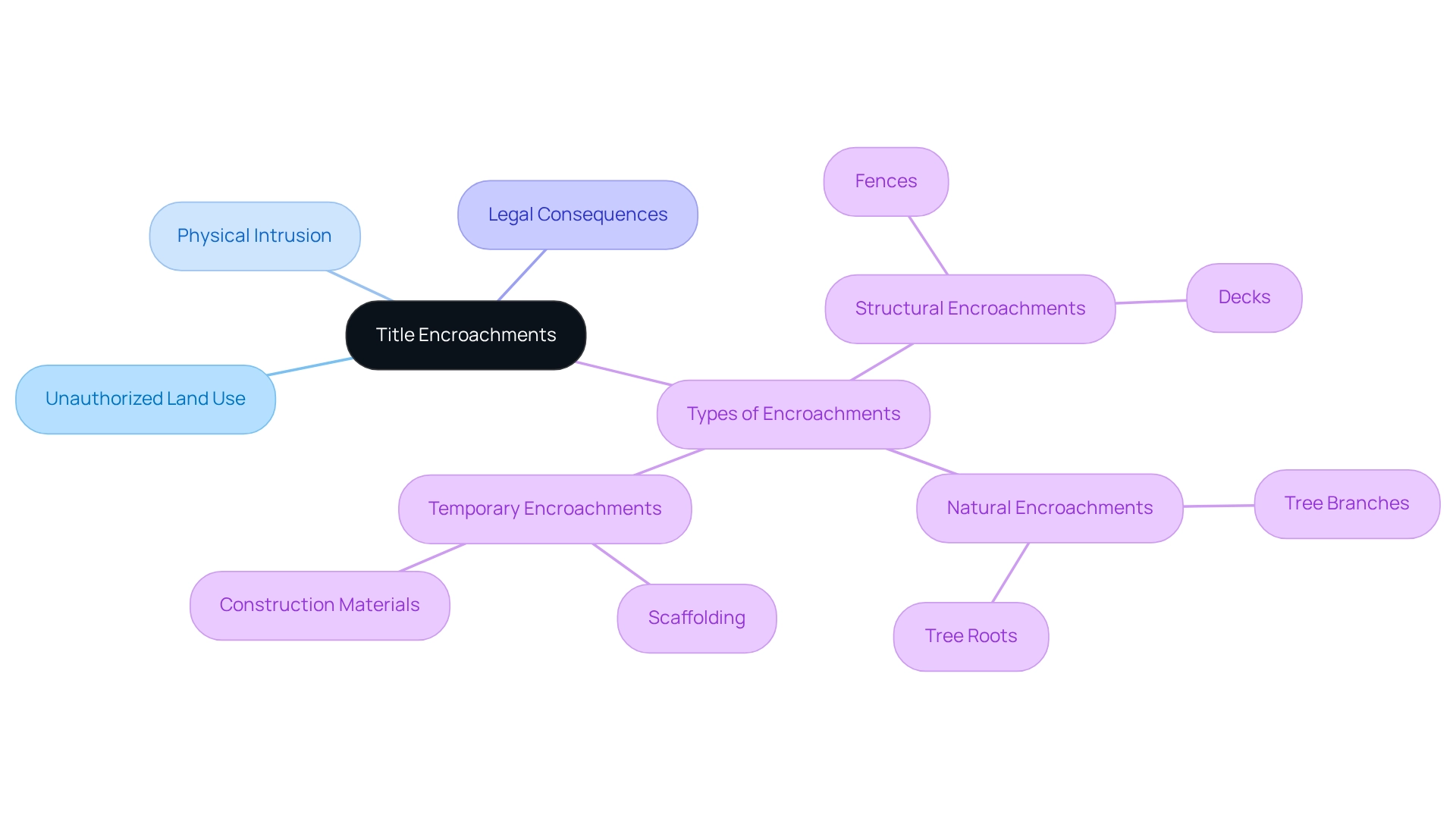Overview
Title encroachments denote instances where a landholder unlawfully extends a structure or feature onto an adjacent property, infringing upon established boundary lines. This breach can incite disputes and adversely affect property values. Understanding these encroachments is paramount, as they:
- Complicate real estate transactions
- May establish prescriptive easements
- Can deter lenders from approving mortgages for affected properties
Therefore, it is crucial to implement proactive measures and seek legal guidance to effectively manage these issues.
Introduction
In the intricate world of real estate, the issue of title encroachments looms large, often leading to legal headaches and financial ramifications for property owners. These encroachments occur when a structure or feature unlawfully extends onto a neighboring property, complicating transactions and clouding titles. It is essential for both current and prospective homeowners to understand their implications, especially considering that statistics indicate nearly one in five properties may be affected.
The stakes are high. From structural intrusions like fences to natural encroachments such as tree roots, the types of violations vary significantly, and the potential for disputes is considerable. Furthermore, as urban development continues to reshape property lines, the evolution of property law becomes increasingly relevant, highlighting the necessity for vigilance and proactive measures in managing property rights.
Define Title Encroachments
To understand what are title encroachments, it is when a landholder unlawfully extends a structure or feature onto , thereby breaching established boundary lines. Common examples illustrate what are title encroachments, including physical structures such as fences, buildings, or landscaping elements that encroach upon neighboring areas. These intrusions can lead to significant conflicts among landowners, raising concerns about what are title encroachments, complicating transactions and potentially impacting the marketability and legal standing of the title. Statistics indicate that approximately 20% of properties may experience some form of intrusion, which can deter lenders from approving mortgages for affected properties.
are substantial; unresolved intrusions may result in the establishment of prescriptive easements, thereby limiting a homeowner's options for resolution. As Demetri A. Braynin advises, "it is always best to discuss specific details with counsel to avoid any post-closing complications." Experts recommend addressing intrusions promptly to avert escalation into legal disputes, underscoring the importance of seeking guidance from knowledgeable real estate attorneys when necessary. Recent cases highlight the complexities arising from title infringements, which raises the question of what are title encroachments, emphasizing the need for vigilance and proactive measures in asset management. Furthermore, intrusions can affect tax rates and evaluations, further complicating the financial ramifications for landholders.
Contextualize Title Encroachments in Real Estate
In the realm of real estate, title intrusions hold significant importance due to their potential to incite disputes and affect asset values. When a landholder encounters an intrusion, the complexities of selling the asset increase, as prospective buyers may hesitate, fearing litigation. Furthermore, intrusions can create clouds on the title, complicating the process of securing financing or insurance.
California courts employ the 'Relative Hardship Doctrine' to evaluate the appropriate response to intrusions, balancing the interests of both the intruding party and the affected landholder. This legal principle is vital for real estate stakeholders to understand, as it can influence the outcomes of conflicts and the potential for easements.
Promptly addressing violations is essential to avert future complications and possible asset loss. According to LS Carlson Law, "By comprehending the essence of intrusions, its possible repercussions, and the measures required to tackle the situation, California landowners can safeguard their rights and uphold a harmonious relationship with their neighbors."
must remain vigilant in identifying and addressing infringements to protect their clients' interests and facilitate smooth transactions. Data from February 2019 indicates that there was one archive entry related to legal conflicts stemming from unresolved intrusions, underscoring the necessity for proactive measures in asset management.
Trace the Origins of Title Encroachments
The origins of what are title encroachments are deeply embedded in the evolution of real estate law, which has transformed significantly over the centuries. Initially, land boundaries were often unclear, leading to frequent conflicts among landowners. As societies advanced, legal structures developed to clarify ownership rights and boundaries more explicitly. This evolution was crucial in addressing the complexities of ownership and the rights associated with it.
Philosophically, Locke contended that the possession of private assets is one of the primary reasons for the existence of the state, highlighting the fundamental significance of ownership rights. Furthermore, C.B. MacPherson's interpretation of Locke's political philosophy emphasizes possessive individualism, suggesting that ownership rights rationalize capitalist appropriation and support bourgeois interests.
With the growth of urbanization, the issue of intrusions became increasingly noticeable, as buildings started to be erected nearer to boundary lines. Currently, regulations concerning what are title encroachments vary among jurisdictions; however, the fundamental principle remains that landowners must respect their neighbors' limits to reduce possible disputes.
cautions that unlawful possession of real estate can weaken rightful ownership, emphasizing the essential requirement for clear definitions in law and compliance with established limits. Consequently, the interaction between urban growth and real estate regulations continues to influence the environment of title disputes, highlighting the importance of understanding what are title encroachments, making it crucial for real estate experts to remain updated on these changing standards.
Lucy Parsons' analysis of ownership rights, claiming that they have overshadowed human rights, provides an important viewpoint on the societal effects of land ownership and intrusions.

Identify Key Characteristics and Types of Title Encroachments
Key features of title invasions encompass unauthorized land use, physical intrusion onto a neighbor's estate, and the potential for legal consequences. For property owners and real estate professionals, understanding what are title encroachments is essential to mitigate disputes and protect property rights. Common types of encroachments include:
- Structural Encroachments: These involve buildings or extensions, such as a fence or a deck, that cross property lines.
- Natural Encroachments: This can include tree branches or roots that extend into a neighbor's yard.
- Temporary Encroachments: These may involve items like scaffolding or construction materials that unintentionally extend onto neighboring areas.
Understanding what are title encroachments is crucial, as it not only aids in resolving potential conflicts but also reinforces the importance of in safeguarding property rights.

Conclusion
Title encroachments represent a significant concern for property owners, with the potential to lead to legal disputes and financial complications. Understanding the nature of these encroachments—whether structural, natural, or temporary—is essential for navigating the complex landscape of property rights. As highlighted, nearly 20% of properties may be affected, underscoring the prevalence of this issue and the importance of vigilance.
The complexities surrounding title encroachments are further compounded by evolving property laws and the need for proactive measures. Legal frameworks, such as the 'Relative Hardship Doctrine' in California, provide a basis for resolving disputes; however, they also emphasize the necessity for property owners to act promptly. Engaging with experienced real estate professionals and attorneys can help mitigate the risks associated with encroachments, ensuring that property rights are protected and disputes are resolved amicably.
In a world where urban development continues to reshape property boundaries, the implications of title encroachments extend beyond legalities to affect marketability, financing, and insurance. By recognizing the significance of maintaining clear boundaries and addressing encroachments swiftly, property owners can safeguard their investments and foster harmonious relationships with their neighbors. Ultimately, a proactive approach to understanding and managing title encroachments is essential for navigating the complexities of real estate ownership in today's dynamic environment.
Frequently Asked Questions
What are title encroachments?
Title encroachments occur when a landholder unlawfully extends a structure or feature onto an adjacent plot, breaching established boundary lines. This can include physical structures like fences, buildings, or landscaping elements that intrude upon neighboring areas.
What are some common examples of title encroachments?
Common examples include fences, buildings, or landscaping elements that extend onto a neighboring property, leading to conflicts among landowners.
How prevalent are title encroachments?
Statistics indicate that approximately 20% of properties may experience some form of intrusion.
What are the legal implications of title encroachments?
Unresolved intrusions may lead to the establishment of prescriptive easements, which can limit a homeowner's options for resolution and complicate transactions.
What should homeowners do if they encounter a title encroachment?
It is recommended to address intrusions promptly to avoid escalation into legal disputes, and homeowners should seek guidance from knowledgeable real estate attorneys to navigate the situation.
How can title encroachments affect property transactions?
Title encroachments can complicate transactions and potentially impact the marketability and legal standing of the title, which may deter lenders from approving mortgages for affected properties.
What financial ramifications can result from title encroachments?
Intrusions can affect tax rates and evaluations, further complicating the financial implications for landholders.




